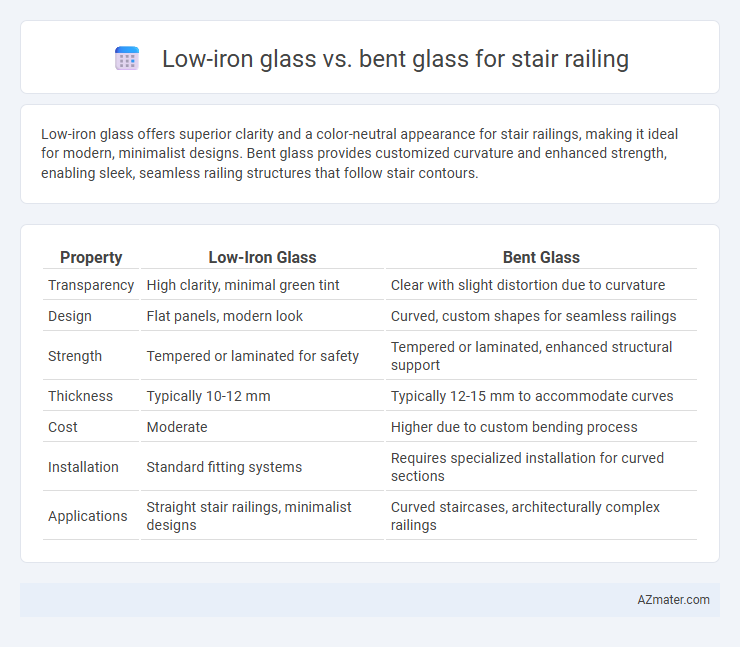Low-iron glass offers superior clarity and a color-neutral appearance for stair railings, making it ideal for modern, minimalist designs. Bent glass provides customized curvature and enhanced strength, enabling sleek, seamless railing structures that follow stair contours.
Table of Comparison
| Property | Low-Iron Glass | Bent Glass |
|---|---|---|
| Transparency | High clarity, minimal green tint | Clear with slight distortion due to curvature |
| Design | Flat panels, modern look | Curved, custom shapes for seamless railings |
| Strength | Tempered or laminated for safety | Tempered or laminated, enhanced structural support |
| Thickness | Typically 10-12 mm | Typically 12-15 mm to accommodate curves |
| Cost | Moderate | Higher due to custom bending process |
| Installation | Standard fitting systems | Requires specialized installation for curved sections |
| Applications | Straight stair railings, minimalist designs | Curved staircases, architecturally complex railings |
Introduction to Stair Railing Glass Options
Low-iron glass offers superior clarity and a near-transparent appearance, making it ideal for stair railings where enhanced aesthetics and natural light transmission are priorities. Bent glass, shaped through heat-curving techniques, provides customized, seamless designs suitable for modern staircases needing smooth, continuous glass panels without visible joints. Both options ensure durability and safety, but choosing between low-iron and bent glass depends on the desired visual impact and architectural style of the stair railing.
What is Low-Iron Glass?
Low-iron glass, also known as ultra-clear glass, is specially manufactured with reduced iron content to enhance transparency and minimize the green tint typically seen in standard glass. This high-performance glass offers superior clarity and color neutrality, making it an ideal choice for stair railings where aesthetics and unobstructed views are paramount. Compared to bent glass, which is shaped for structural design, low-iron glass prioritizes visual purity and light transmission, creating a sleek, modern appearance in architectural applications.
Understanding Bent Glass for Stair Railings
Bent glass for stair railings offers enhanced strength and safety by being thermally treated and shaped to fit curved designs, providing a seamless and elegant finish ideal for modern architectural styles. Unlike low-iron glass, which primarily focuses on clarity and reduced green tint, bent glass maintains structural integrity while conforming to custom shapes without compromising durability. This combination of form and function makes bent glass a preferred choice for stair railings that require both aesthetic appeal and reliable performance.
Optical Clarity: Low-Iron vs. Bent Glass
Low-iron glass offers superior optical clarity compared to bent glass, featuring higher transparency and reduced green tint due to its low iron content, making it ideal for staircase railings where clear, unobstructed views are crucial. Bent glass, while customizable in shape and often tempered for strength, exhibits slight distortion and reduced clarity because the bending process can create minor optical imperfections. Choosing low-iron glass ensures a crisp, vivid visual experience in stair railing applications, enhancing safety and aesthetic appeal.
Strength and Durability Comparison
Low-iron glass offers superior clarity and aesthetic appeal but has comparable strength to standard glass used in stair railings. Bent glass, formed through heat shaping, provides enhanced structural strength due to its curved design, distributing stress more evenly and reducing the likelihood of breakage. For stair railing applications, bent glass often delivers greater durability and resistance to impact compared to flat low-iron glass panels.
Design Flexibility and Aesthetics
Low-iron glass offers superior clarity and a brighter, more transparent appearance compared to standard glass, enhancing the sleek, modern aesthetic of stair railings with minimal green tint. Bent glass provides unique design flexibility by allowing curved and custom shapes that create seamless, flowing lines ideal for contemporary architectural styles. Combining low-iron glass with bent shapes maximizes both visual purity and dynamic form, resulting in visually striking and elegant stair railing solutions.
Installation Considerations
Low-iron glass offers higher clarity and a sleek aesthetic but typically requires precise handling and specialized hardware during installation to prevent chipping and ensure secure fitting. Bent glass, shaped through heat treatment, demands experienced installers familiar with its unique curvature to align and mount properly on stair railings, often leading to longer installation times. Both types necessitate accurate measurements and professional-grade tools to maintain safety standards and achieve flawless integration with the staircase structure.
Cost Analysis: Which is More Affordable?
Low-iron glass typically costs 20-30% more than bent glass due to its higher purity and clarity, making it a premium choice for stair railings. Bent glass, manufactured through a heating and shaping process, generally offers a more budget-friendly option while providing adequate strength and aesthetic appeal. For cost-sensitive projects, bent glass is more affordable, but low-iron glass delivers enhanced transparency and brightness that may justify the additional expense.
Maintenance and Cleaning Differences
Low-iron glass for stair railings resists staining and requires minimal cleaning due to its high clarity and reduced impurities, making smudges and dirt less noticeable. Bent glass, often used for curved or custom shapes, may accumulate more dirt in its creases and curves, necessitating more frequent and careful cleaning to maintain a clear appearance. Maintenance for bent glass often involves specialized cleaning tools to reach all angles, whereas low-iron glass can be easily cleaned with standard glass cleaners and soft cloths.
Choosing the Best Glass for Your Stair Railing
Low-iron glass offers superior clarity and minimal green tint, making it ideal for stair railings where aesthetics and transparency are paramount. Bent glass provides custom curved shapes that enhance design flexibility and safety by fitting specific stair configurations seamlessly. Selecting the best glass involves balancing the visual clarity of low-iron glass with the architectural adaptability of bent glass, tailored to your stair railing's style and structural needs.

Infographic: Low-iron glass vs Bent glass for Stair railing
 azmater.com
azmater.com